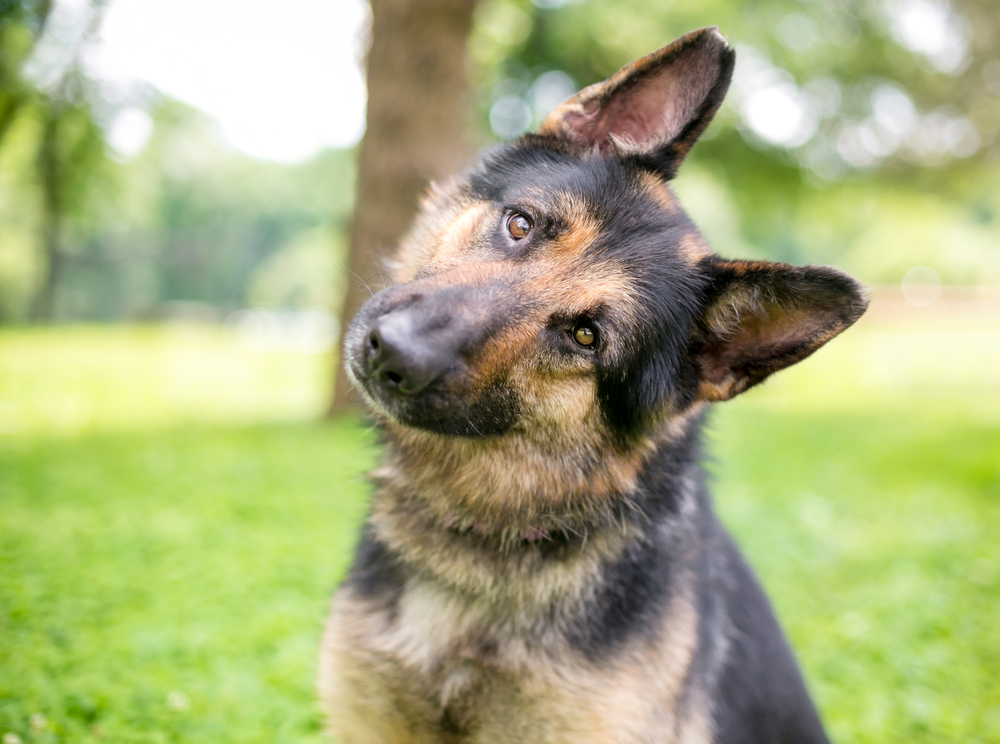Why Do Dogs Tilt Their Heads to One Side?
Posted on Categories Discover Magazine

You already know the look: Your dog is staring up at you, its eyes shining with curiosity and ears perked up. And, of course, the pup’s head is cocked slightly to one side in response to the sound of your voice.
It’s just one of the many charming quirks that dogs possess. And a quick Google search will offer up plenty of theories for their adorable head-tilting behavior. For example, some veterinarians suggest that dogs tilt their heads toward their owners to show that they are engaged and prolong the interaction, similar to the way that humans nod during a conversation to show that we’re listening.
But surprisingly, little research has investigated the reasons behind it. A recent study, however, may offer some hints — and suggests that the head-tilt could be a sign that your canine companion is trying to better understand you.
Studying the Head-Tilt in Dogs
Researchers have found that plenty of animals — fish, reptiles, birds, mammals and even humans — process sensory information asymmetrically, meaning that they use the left or right side of their brain. Other studies demonstrate that dogs display this asymmetry, too, often wagging their tail to one side or sniffing with one nostril over the other.
But when it comes to head tilting in dogs, the scientific literature is far scarcer. “It’s a very common behavior in dogs,” says Andrea Sommesse, an animal behavior researcher at Eötvös Loránd University in Hungary. “There are a lot of anecdotes and stories and all that, but there was no scientific publication on this.”
Read More: Why Does My Dog Bark So Much?
That is, until Sommese and his colleagues found that “gifted” dogs — meaning those that could memorize the names of a number of different toys — frequently cocked their heads to the side before correctly fetching a specific toy. The team published their results in the journal Animal Cognition in late 2021.
An Unexpected Discovery
Sommese says that the finding came as a surprise; the scientists stumbled upon it while conducting a small study of gifted “word learner” dogs. While most dogs have a hard time learning the names of even two toys, these seven special pups could remember and retrieve at least 10 different toys, by name, after learning them from researchers.
What’s more, the team saw that the pups with a penchant for playing fetch cocked their heads after being prompted with a command (“bring rope!”) more often than their less-skilled peers. That’s when Sommese and his colleagues decided to dig deeper.
Read More: Dogs Have Co-Evolved With Humans Like No Other Species
“All of us noticed this,” he adds. “So we started talking about it, because it was getting more and more consistent. And then we decided to analyze it.”
Why Do Dogs Tilt Their Heads?
In the 2021 study, which took place over several months, the scientists compared the retrieval abilities of the seven “gifted” dogs — all of them border collies — with those of 33 “typical” dogs. Sommese says they designed the experiment with the dogs in one room and the toys in another.
Nalani, one of the gifted “word learner” dogs featured in the study, sits atop a treasure trove of toys. (Credit: Sonja De Laat Spierings)
“So [the dogs] don’t actually see the toys,” he continues. “And when the owner asks for a toy by name, [the dog] hears the word, the stimulus, and they’re like, ‘Okay, let me think about this. What is it?’ And then they go and fetch it.”
The study authors found that when prompted by a command from their owner, the gifted dogs cocked their heads 43 percent of the time, compared to just 2 percent of the typical dogs. Thus, the head tilt could be a sign of mental processing — meaning that the pups are likely paying attention or even matching the toy’s name with a visual memory of it in their head.
“[The head tilt] is a way to think about something,” adds Sommese. “To get what we call a ‘mental representation’ of the item or the toy.”
Other Reasons Dogs Turn Their Heads
Monique Udell, an animal behaviorist who studies human-animal interactions at Oregon State University, notes that there could be other explanations for the head-tilting behavior beyond concentration and recall.
“Maybe it helps them see better or hear better — and get a different perspective,” Udell says. “Lots of species will move their heads or bodies to respond to important stimuli in order to get a better sense of what that thing is.”
Going forward, she hopes that scientists will investigate whether different breeds of dogs tilt their heads in response to other factors in their environment, as well.
“Maybe another dog howling, or the sound of a prey animal if they’re a hunting dog,” says Udell. “I’d be interested to know if the head tilting is truly specific to this kind of stimuli, or if we can understand if head tilting in different dogs corresponds to different stimuli that are important to them.”
Sommese says that he’d like to follow up on his study by looking at populations of non-gifted dogs to see if hearing familiar words triggers the same response. And while research on the connection between canine cognition and head tilting is still in its early stages, for now, the next time your pup cocks its head, you can probably chalk it up to an adorable attempt to process what you’re saying.
Read More: We’ve Relied On These 5 Animals Throughout History